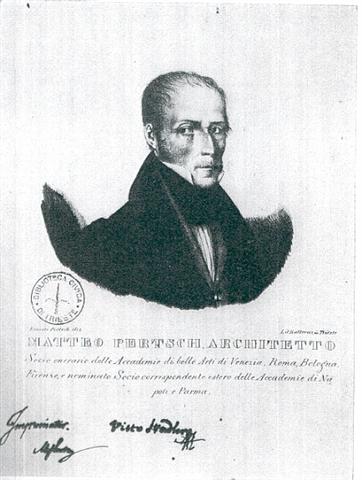He arrived in Trieste called "to erect his grandiose factory on the Grand Canal" by the Greek Demetrio Carciotti, a merchant who settled in Trieste in 1775. Pertsch's thriving business from Trieste began, therefore, in 1798 as Privat-Architekt with a decidedly important job: in the same year the architect presented the drawings for what will be considered by Giuseppe Righetti "the most beautiful work of Pertsch, the most majestic, the greatest [...] the great house, or we mean Demetrio Carciotti's palace, rich and generous Greek shopkeeper . [...] its prospect towards the sea, still remains [1865 Ed] the only architectural work of a private individual, remarkable for its sumptuousness, beauty, richness and movement and perspective effect found in Trieste, which facade he rightly had the pompous name of the palace given to the whole ».
The construction superintendent was Giovanni Righetti and the author of the sculptures was Antonio Bosa, a pupil of Antonio Canova. The works ended only in 1806 (although the date 1800 appears on the facade); It is known for certain that Pertsch adopted the fire-fighting measures promulgated in 1801 in this project.
In 1799, Pertsch participated in the competition organized by the mercantile class to «erect a building on one of Borsa, worthy of witnessing to the late grandchildren the prosperity and triumph of the preserved franchises and the declaration of free port with the commercial trinity», but the Academy of Parma preferred the designs of Antonio Mollari. According to Giovanni Righetti's testimony, however, some suggestions by Pertsch were accepted in the final project.
In the same year, work began at the Teatro Nuovo in Trieste, designed by the famous Venetian architect Giannantonio Selva (author of the La Fenice Theater in Venice): Pertsch, still engaged in the works of Palazzo Carciotti, was commissioned to create an imposing facade in adaptation of the new plan imposed by the Vienna government. With this architectural work Matteo Pertsch demonstrated his artistic independence and his ability to adapt to pre-established building conditions, despite his work showing significant similarities with the Teatro alla Scala del Piermarini and other Lombard examples.
One of the most interesting and original works of Pertsch is the Rotonda Pancera, a semicircular facade building. The construction work was entrusted to Giovanni Righetti from Ticino. The construction of the Rotonda is to be dated, among other things, around 1805: this would explain the stylistic affinity with Palazzo Carciotti, which ended the same year.
San Nicolò dei Greci
In 1807 Pertsch left Trieste following the French occupation to move to Graz, gaining some fame also in Styria and Carniola with both public and private works. He returned to Trieste in 1817 to never leave, continuing the thriving business he had left ten years earlier. An explanation for the large number of tasks entrusted to Pertsch at the beginning of the nineteenth century still comes from Righetti: "That artist had a profound practice in construction that gave his works that convenient solidity, without exceeding unnecessary and large expenses, he also knew how to remedy the defects which technicians repeatedly encounter. As far as we know he was one of the first to introduce the most remarkable improvements in masonry constructions, and in the systems and shapes of the ironwork of the doors and windows, such as the spagnolette, the strips and the patches embedded in the thickness of the wood, and others. For which things he rose so much reputation, that he was overwhelmed with technical-artistic commissions, and the craftsmen all had so much confidence in him, that he had almost become the common father or protagonist; and several were the chief masters who were trained by him "[1]. Among these buildings we can remember the Casa Covacevich (formerly Mauroner - 1821), the Casa Steiner in Corso Italia (1824) and the so-called Casa Recher (1833), demolished in 1911.
Matteo Pertsch intervened with plans and proposals in the construction of the Catholic cemetery of Sant'Anna around 1822 and had previously carried out surveyor works in the north-western part of the same, aimed at the construction of the cemetery of the Greek-eastern community, for which he designed and also built the facade and two bell towers of the church of San Nicolò (1819). From 1820, the Deputation of the Stock Exchange turned to him as a councilor, expert or entrepreneur for various positions, also entrusting him with various projects which were then not carried out for various reasons. Contrary to what many have said, the lighthouse of the Old Lantern was not the work of Pietro Nobile but of Pertsch, who presented between 1824 and 1831 at least six projects for the realization. Just in 1831 Pietro Nobile, of the Aulica Management of the Vienna Factories, endorsed the beginning of the works.
Pertsch's activity was also oriented in other directions: he was "estimator of buildings and building expert" and intervened in the public interest on various problems and proposals for the construction of prisons and for the supply of drinking water. He lent his work to the government and the magistrate and was called to be part of various municipal commissions. For two years he held the chair of Civil Architecture at the Royal and Nautical School (inaugurated in 1818). He was also accepted into many Academies as a Member of Honor, such as that of San Luca in Rome (1825) and then to the Fine Arts of Florence (1825), Venice (1826), Parma, Bologna and Naples (1827).
His vast experience in the architectural field gave him the opportunity to devise real inventions, such as perforated stone flues instead of the usual masonry fireplaces, the adoption of economic hotbeds and rubbish selection grates. He translated the essay on the properties and effects of the vaults of the architect Karl Friedrich Meerwein from German, with a dedication to Count Gabriele di Porcia and a preface.
Giuseppe Righetti said of Pertsch: «He was a well versed man in the history of the arts, in geometry, in mechanics, and also in fine letters. His architectural concepts are graceful, harmonious, varied and characteristic to the subject. He loved the application of orders in the compartments in the facades with arches and arched windows with bas-reliefs, shutters and tanning of good profiles and resentful. "
In 1802 Pertsch married Maddalena Vogel who gave him four sons and three daughters. Three of the males followed in their father's footsteps on the road of art, among them Nicolò continued his architectural activity especially in Trieste, having obtained the authorization prescribed in 1835.
Matteo Pertsch's most important pupil was Antonio Buttazzoni (1800 - 1848) who began his career in his studio and attended the Brera Academy for more than two years. The influence of the master was never hidden by Buttazzoni, who worked a lot since 1824, especially in Ljubljana.
Despite the often uncomfortable attitudes towards the authorities and the accidental disagreements with his colleagues (including Pietro Nobile and Giuseppe Sforzi), Matteo Pertsch enjoyed the highest consideration in Trieste both in the public and private sectors. Giuseppe Righetti provided, in this regard, some interesting information about the person of Pertsch: «The character of M. Pertsch was what Vitruvius suggests it to architects; that is, honest, loyal, prudent, beneficial, affable and mannered with all without ostentation: he listened and made profit from others' opinions and advice; he knew how to distinguish skills and protect them, find virtuous people and become friends with them. So much was he indoctrinated in art, that he gave birth to an interesting operetta around the construction of the vaults, if memory cannot be deceived. Since he was suffering in health at a tested age, he sometimes exceeded in causticity and irritation, but he quickly recovered. "
Matteo Pertsch died of a long illness at the age of 60 on 11 April 1834.
MATTEO PERTSCH
Matteo Pertsch was born in 1769 (1770 or 1774, according to other sources) to a family of German origin in Buchhorn on Lake Constance and left his homeland in 1790 to attend the Brera Academy of Fine Arts in Milan. At the same time, the greatest master of Italian Neoclassicism, Giuseppe Piermarini (professor in Brera between 1774 and 1799 and architect of the Teatro alla Scala in Milan) was active in the Lombard capital and his lesson certainly left a profound mark on the young Pertsch. In 1794 Matteo won the First Architecture Prize in the competition of the Ducal Academy of Fine Arts in Parma with a project for a Royal Mint. The hopes of being hired at the Milanese Academy vanished with the French occupation of Milan and Pertsch was forced to repair in Bergamo.







